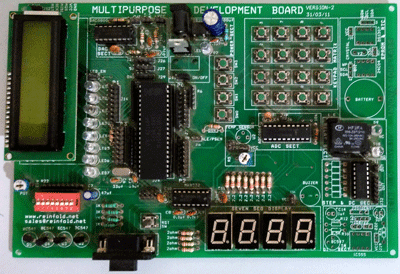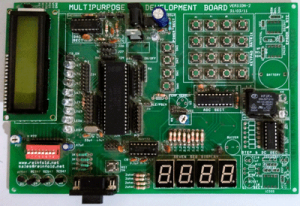Going on a trek or a road trip or learning microcontrollers, none of them are less than an adventure. (Been there.. trust me) . To begin with one needs a board i.e. a printed circuit board which comprises necessary circuitry to support the microcontroller being used. Just like a vehicle for your road trip… That’s not enough to develop applications; you’ll need peripherals like sensors, converters and so on. A PCB that comprises peripherals, the MCUs (Micro Controller Unit) and support circuitry qualifies as a Development Board where one can develop useful applications. P89V51RD2 Development Board / 8051 Development Board (DB) from Reinfold labs is a good DB to begin with.
8051 Development Board uses the 8051 MCU which are one of the earliest and easiest to learn and implement applications. 8051 Development Board is In-System-Programmable i.e. developers can edit, rebuild and program the MCU without the need to remove it from the board. In other words, separate programmer for MCU is not required as it can be done on board or in system. RS232 cable is used to connected between PC and 8051 Development Board.
Key features of 8051 Development Board:
- Microcontroller: P89V51RD2 with 11.0592MHz crystal.
- Double side high quality PCB board to provide extra strength to the connector joints for increased reliability.
- Power: 12 DC, Heat sink on 7805 for better current rating.
- Reverse polarity protected.
- Switches: Reset, Power.
- RS232 serial interface.
- 10 pin FRC connectors and soldering pads on all ports.
- Compatible with General purpose prototyping board for development board for stackable design.
The 8051 Development Board from Reinfold Labs comprises following peripherals for smoother developing process,
- 8 LEDs
- 7 Segment Display
- 16×2 LCD Display
- 4×4 Keypad Matrix
- ADC0804
- DAC0800
- 5V Sugar Cube Relay
- Stepper Motor
- Buzzer
- DIP Switch
Programing the 8051 Development Board
This part involves two steps and two software. One is Keil Micro Vision and other is Flash Magic. First step is to write a code, build and generate the HEX file. This can be done using Keil. Second step is to dump the HEX file onto the MCU on 8051 Development Board. This is accomplished by using Flash Magic.
Conclusion:
8051 Development Board is user friendly and a good choice for beginners. In addition to that, it can be used by students, professionals, hobbyists and in industry.
Posted By Siraj Sanadi



